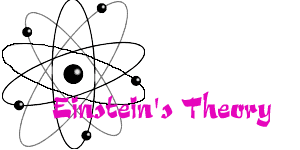

|
|
|
Matter can be changed into energy. The famous scientist
Albert Einstein created the mathematical formula that explains this.
It is: E = mc2 E [energy] equals m [mass] times c2 [c stands for the speed of light. c2 means c times c, or the speed of light raised to the second power -- or c-squared.] [Energy (in joules) = Mass (in kilograms) X The Speed of Light Squared (in meters squared per second squared) This equation has become an icon, or a trade mark for science, and is not really viewed as the equation by the majority of people. It seems to be viewed in the same light as a company logo like Nike, Almost everyone recognises it and are vaguely aware of it's connection with Albert Einstein and may know it has something to do with mass and energy, even though they have never seen the formula as it is shown above. In his article "Astrophysics for a Ten-Year-Old Mind" Michael Chabin explained that the formula could be understood by a 10 year old, providing the basics were explained, especially that one of the remarkable findings of the century is that matter and energy are two forms of the same thing. Neither can be destroyed but, under special circumstances, either can be turned into the other. This is important. All the matter in the universe condensed out of pure energy over a period of about 700,000 years shortly after the Big Bang, and today, stars shine because matter at their centers is being slowly converted back into energy. Both annihilation of matter into energy and condensation of matter out of energy have been demonstrated in the laboratory. One of the most amazing things about all this is that a simple equation will tell you exactly how much energy a given amount of mass contains.
|
|
His method was to write e=mc2
at the top of a piece of paper. Then take a moment or two for her to
tell you what she knows about the equation.
Begin with the speed of light.
Mass is next. It is given in kilograms, and, since a litre of water is defined to have a mass of one kilogram, most kids have no trouble with this unit. Because you want to know how much energy is in one litre of water, the mass term is equal to 1 and the equation becomes:
|
|
The problem is, of course, understanding what your answer means. Energy is given in joules and not many kids know what a joule is. But they should; it is an extremely intuitive unit. A joule is the effort required to push one kilogram over a metre at an acceleration of one metre per second squared. To get a feel for it, pick up a litre bottle of water and toss it ten centimetres into the air. You've just expended about a joule. Here are some others:
|
|
On (very) tiny scales...
|
|
On human scales...
|
|
On planetary scales...
|
|
On astronomical scales...
|
|
A joule expended continuously for one second is a watt, which means a litre of water, converted to energy could power a 1 watt light bulb for 9<<1016 seconds, or 2.5<<1013 hours. Of course if it were a 100 watt bulb it would only burn for 2.5 x 1011 hours, and you might find it more interesting to burn 1011 light bulbs for two and a half hours instead. It is then reasonable to ask how large an area that many light bulbs would cover.She will find, after a little work (especially if she hasn't seen square roots yet), that if she allows an area of about 10 cm by 10 cm for each bulb, she can tile a square roughly thirty-one kilometres on a side with 1011 light bulbs.
|
|
What you've just done is arithmetic. Now for the science.
What is important is that having played with the equation once, they will know that it is tractable, accessible, and so much more than a trademark of science.
|
 |
| "You may think that a stich in time saves nine, but this would really confuse poor old Einstein" |
![]()
|
Office
|
Quiz
|
![]()